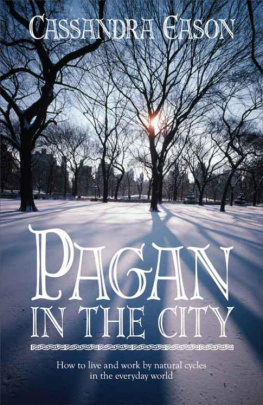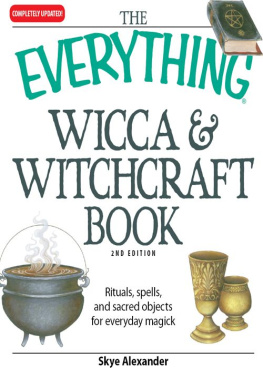Contents
A LITTLE BIT
OF
WICCA

AN INTRODUCTION TO
WITCHCRAFT
CASSANDRA EASON


STERLING ETHOS and the distinctive Sterling Ethos logo are registered trademarks of Sterling Publishing Co., Inc.
Text 2017 Cassandra Eason
All rights reserved. No part of this publication may be reproduced, stored in a retrieval system, or transmitted in any form or by any means (including electronic, mechanical, photocopying, recording, or otherwise) without prior written permission from the publisher.
ISBN 978-1-4549-2716-7
For information about custom editions, special sales, and premium and corporate purchases, please contact Sterling Special Sales at 800-805-5489 or .
sterlingpublishing.com
Image Credits: iStock: Del_Mar: 109-114; PeterHermesFurian: ; Shutterstock: Verpeya: throughout (pentagram)
CONTENTS

INTRODUCTION
WHAT IS WICCA, ITS ORIGINS, AND HOW THE MAGICK WORKS
Wicca, the craft of the wise, is the practical expression of the spiritual and belief system of those who work seriously and reverently with magick. It is centered on the conscious and responsible use of natural, cosmic, and personal psychic powers to move thoughts into actuality through the raising, amplifying, concentration, and release of these energies. Wicca is also the name of the major organized religion of neo (or new) pagan witchcraft, which is based on ancient magickal practices. Gerald Gardner formed the first formally established neo pagan worship group in the years after the repeal of the Witchcraft Act in 1951 in the UK, though of course there were hereditary witches in America, Europe, and indeed throughout the settled world. Pagan, which comes from the Roman word paganus, or country dweller, refers to natural forms of spirituality, both organized and personal, of those who follow the cycles of the year and the seasons, as Wiccans do.
In the home, the family matriarch throughout the centuries and in many cultures had secret recipes, remedies, and folk customs, which were passed down orally through the generations, as well as rituals and charms to bring love, prosperity, fertility, healing, and protection to the family members and the home. Many older people in Scandinavia and Europe and those of Scandinavian and Eastern or Western European descent in the Americas, Australia, New Zealand, and South Africa can still recall their great grandmothers carrying out such magick as part of the family folk custom. There are many variations of Wicca, and some witches do not call themselves Wiccans. Some Wiccans work primarily as healers and ecologists rather than magickal practitioners.
A Little Bit of Wicca is a comprehensive guide to practicing Wicca, whether you are a total beginner or are already on the path and wish to learn more about the methods and structure of Wicca.
WHO ARE WICCANS?
Wicca can be defined as the craft of those who seek, and hopefully attain, wisdom and create or carry out ceremonies to celebrate and give energies to the rising and falling year.
There is a vast amount of information now available about Wiccan practices and about its complex but fascinating origins that helps to show the richness and beauty of the tradition. This information also depicts the great suffering that witches in past centuries have experienced in order to keep Wiccan traditions alive and evolving. Above all, Wicca is not set in stone but is constantly changing through the wisdom and experiences of every witch who contributes fresh insights. And so, having studied the basic structure, you are free to, and indeed should, create your own unique path.
Wiccans may be Christian, Buddhist, belong to any other religion, or belong to none, but all positively recognize a higher and eternal source of goodness and light.
WHAT IS MAGICK?
Magick is a natural energy that is part of the flowing life force that, like any energy, is essentially neutral, which is the reason high ethics must be such an integral part of Wicca and magick generally. By creating chants, specific spells, and more openly structured rituals, we can transform and manifest our positive thoughts and wishes into actuality.
The natural world, even in more formal rituals, acts as a powerhouse of magickal energy that can be used to amplify our personal psychic powers. We can tap into specific times of the day, week, or month and into the ever-changing energies of the sun, moon, seas, lakes, rivers, weather, flowers, herbs, trees, and crystals.
If you ask for something through magick, you should always give a little kindness or encouragement in return to a person, animal, or place in need. That way the positive energies and resources are recycled.
DEDICATING YOURSELF TO THE MAGICKAL PATH
Dedication is the term used for a conscious commitment to the Craft and can be made when you begin magick and/or at any time on your path when you may want to remind yourself of your magickal quest.
Once it was said that only a witch could make another witch, and I respect those who believe that. But increasingly, solitary witches do wish to ceremonially mark their own initial, spiritual commitment to the Wiccan craft and acknowledge the positive spiritual change that working with witchcraft brings within the practitioner.
If you are establishing a coven, you can, each of you, carry out this ritual at the same time in a circle of trees, moving at your own pace, and when you have finished, sit silently and wait until all are seated against their chosen tree. Then rise together and say, in unison, We are the coven of the wise; may we always work in beauty and in sanctity as the [state your new coven name if you have chosen it]. So shall it be.
If you have not already done so, choose a name by which you will be known in the Wiccan crafperhaps a favorite deity, a power animal, or a tree or crystal that has magickal significance for you. Some practitioners use this name in the presence of other witches and speak it aloud when practicing magick. But others believe this name must never be spoken, or even written, as you then give others power over you. This is entirely your choice. It is also often said that this is the name you rediscover from past worlds, where you have previously trodden the path of the wise.
In Chapter 1 we will set up a Wiccan altar and collect and dedicate your magickal tools.


The altar is the heart of any witchs life. Even if you belong to a coven or group of witches, you will still want your own special sacred place at home, as well as a communal one.


















